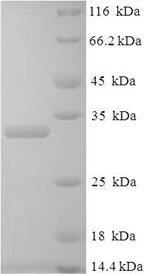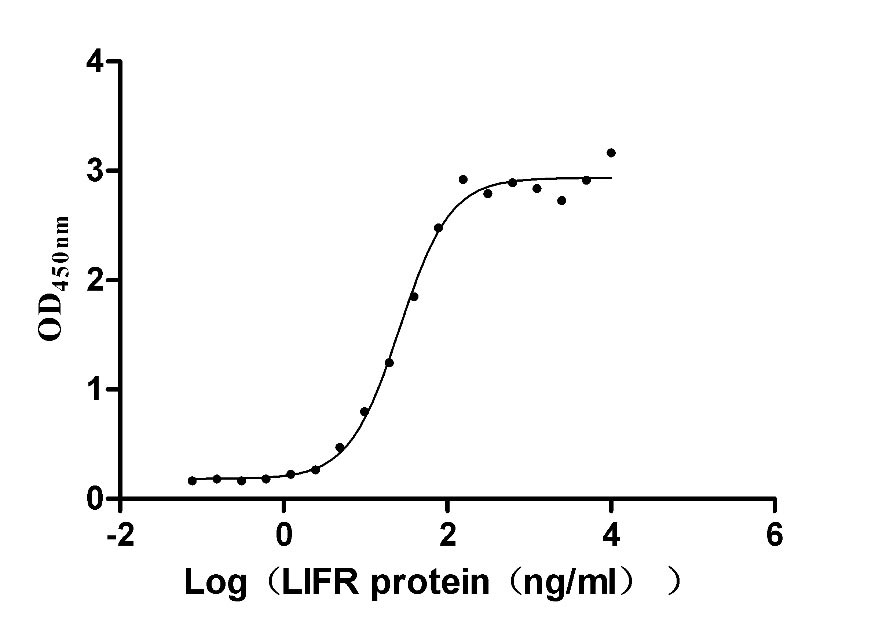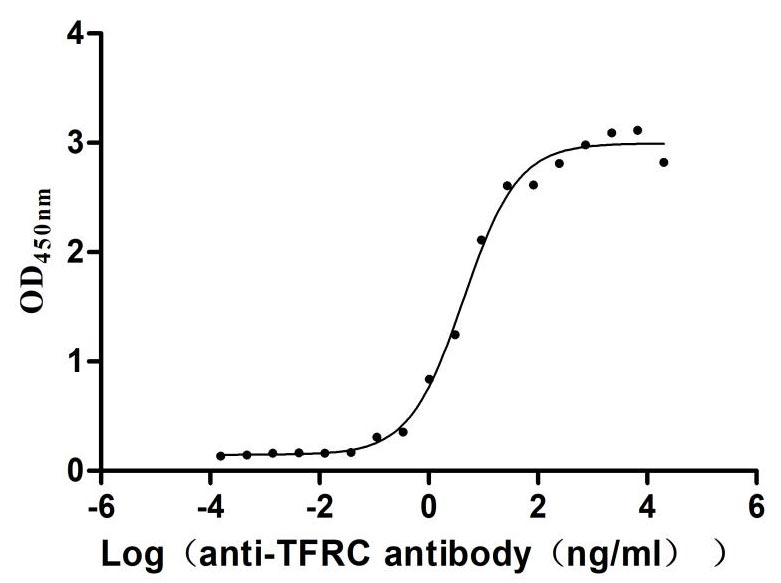Recombinant Human Placenta growth factor (PGF)
In Stock-
货号:CSB-EP017854HU
-
规格:¥1344
-
图片:
-
其他:
产品详情
-
纯度:Greater than 90% as determined by SDS-PAGE.
-
基因名:
-
Uniprot No.:
-
别名:D12S1900; Pgf; PGFL; PIGF; Placenta growth factor; Placental growth factor; Placental growth factor; vascular endothelial growth factor related protein; PlGF 2; PlGF; PLGF_HUMAN; PlGF2; SHGC 10760
-
种属:Homo sapiens (Human)
-
蛋白长度:Full Length of Mature Protein of Isoform PlGF-2
-
来源:E.coli
-
分子量:33.3kDa
-
表达区域:19-170aa
-
氨基酸序列LPAVPPQQWALSAGNGSSEVEVVPFQEVWGRSYCRALERLVDVVSEYPSEVEHMFSPSCVSLLRCTGCCGDENLHCVPVETANVTMQLLKIRSGDRPSYVELTFSQHVRCECRPLREKMKPERRRPKGRGKRRREKQRPTDCHLCGDAVPRR
Note: The complete sequence including tag sequence, target protein sequence and linker sequence could be provided upon request. -
蛋白标签:N-terminal 6xHis-SUMO-tagged
-
产品提供形式:Liquid or Lyophilized powder
Note: We will preferentially ship the format that we have in stock, however, if you have any special requirement for the format, please remark your requirement when placing the order, we will prepare according to your demand. -
缓冲液:Tris-based buffer,50% glycerol
-
储存条件:Store at -20°C/-80°C upon receipt, aliquoting is necessary for mutiple use. Avoid repeated freeze-thaw cycles.
-
保质期:The shelf life is related to many factors, storage state, buffer ingredients, storage temperature and the stability of the protein itself.
Generally, the shelf life of liquid form is 6 months at -20°C/-80°C. The shelf life of lyophilized form is 12 months at -20°C/-80°C. -
货期:3-7 business days
-
注意事项:Repeated freezing and thawing is not recommended. Store working aliquots at 4°C for up to one week.
-
产品描述:
The production of this Recombinant Human PGF protein required the insertion of a DNA fragment (PGF, 19-170aa) into a plasmid vector and the transferral of this vector into E.coli cells (the step of transformation). The cells were then cultured and induced to express the PGF protein. This recombinant protein was fused with N-terminal 6xHis-SUMO tag. Its purity is 90%+ determined by SDS-PAGE.
PGF (also named PGFL or PLGF) is a gene providing an instruction of making a protein named placenta growth factor (also known as PGF or PlGF) in human. PGF protein is a member of the VEGF subfamily, which is a key molecule in angiogenesis and vasculogenesis. Although it was first described in the placenta, it has been identified in low levels in other tissues. PGF protein has been implicated in a variety of physiological processes, including animal organ regeneration, cell differentiation, induction of positive chemotaxis, vascular endothelial growth factor receptor signaling pathway, etc.
-
Datasheet & COA:Please contact us to get it.
相关产品
靶点详情
-
功能:Growth factor active in angiogenesis and endothelial cell growth, stimulating their proliferation and migration. It binds to the receptor FLT1/VEGFR-1. Isoform PlGF-2 binds NRP1/neuropilin-1 and NRP2/neuropilin-2 in a heparin-dependent manner. Also promotes cell tumor growth.
-
基因功能参考文献:
- low serum level associated with stillbirth PMID: 28714317
- sFlt-1/PLGF was positively correlated with the severity of preterm preeclampsia. PMID: 30177039
- The relationship between PlGF and preeclampsia differed in women with obesity according to gestational diabetes status, which may suggest different mechanistic pathways to preeclampsia. PMID: 30177064
- A contingent strategy of measuring the sFlt-1/PlGF ratio at 24-28weeks in women previously selected by clinical factors and uterine artery Doppler enables an accurate prediction of preeclampsia/fetal growth restriction. PMID: 30177066
- modest correlation of serum-free PlGF-1 with placental volume and uterine artery Doppler pulsatility index PMID: 28714779
- PGF expression may have a role in lymphatic invasion, poorer response to chemotherapy and unfavorable prognosis of patients with serous epithelial ovarian cancer PMID: 29643276
- A single measurement of sFlt-1/PlGF ratio at third trimester to predict pre-eclampsia and intrauterine growth retardation occurring after 34weeks of pregnancy. PMID: 29674192
- The levels of sFlt-1, PlGF, and the sFlt-1/PlGF ratio in pre-eclamptic women with an onset at < 32 weeks were sig- ni fi cantly di ff erent from those in women with an onset at >/=32-33 weeks. PMID: 29674208
- In urban Mozambican women with symptoms and/or signs suggestive of preeclampsia, low maternal plasma PlGF concentrations are associated with increased risks of adverse pregnancy outcomes, especially early delivery and stillbirth. PMID: 29523269
- An sFlt-1:PlGF ratio above 655 is not predictive of impaired perinatal outcomes, and insufficiently reliable for predicting outcomes in cases with clinical signs of preeclampsia. PMID: 29523274
- The maternal sFlt-1 to PlGF ratio in women with hypertensive disorders in pregnancy carries prognostic value for the development of preeclampsia. PMID: 29523275
- Lower umbilical cord PlGF levels are associated with lower birth weight, deviating fetal growth patterns, and a higher odds of fetal growth retardation. PMID: 28926825
- Data suggest that circulating PGF levels fall by nearly one quarter during term labor (but not during elective caesarean section). PMID: 29277266
- The cross-talk between tumor-associated macrophages and NSCLC cells via PLGF/Flt-1 and TGFbeta receptor signaling may promote the growth and vascularization of NSCLC. PMID: 29991059
- PlGF level showed an inversely proportional effect on the foetal weight. PMID: 28326518
- Recombinant hPlGF-2 significantly improved contractile function and reduced LV end-systolic and end-diastolic volume indices with a concomitant increase in capillary and arteriolar density in ischemic myocardium, without aggravating atherosclerosis. PMID: 28397162
- these data suggest that PlGF may increase non-small cell lung cancer metastasis through SRp40-mediated mRNA splicing of VEGF. PMID: 28861767
- The present study investigated the interplay of VEGF-A165a isoform, the anti-angiogenic VEGF-A165b, placental growth factor (PIGF) and their receptors, VEGFR1 and VEGFR2, on junctional occupancy of VE-cadherin and macromolecular leakage in human endothelial monolayers and the perfused placental microvascular bed. PMID: 29054861
- PIGF enhances TLR-signaling upstream of IKK and contributes to an exaggerated pathologic pro-inflammatory state in response to activation of maternal and fetal mononuclear phagocytes by specific TLR agonists PMID: 28635072
- Lower PIGF and higher PAPP-A and free beta-hCG levels were found in the fetal circulation of near-term severe preeclamptic pregnancies PMID: 27809614
- The early variations of PIGF and soluble fms-like tyrosine kinase-1 concentrations in newly pregnant obstetric antiphospholipid syndrome (oAPS) may help to detect patients at low risk of placenta-mediated complications (PMC). PMID: 28126966
- There is a significant negative correlation between the concentration of sFLt-1 and PIGF in normal pregnancy. PMID: 26434493
- knockdown of PIGF in spheroid body cells derived from two gastric cancer cell lines reduced in vitro tumorigenicity and stemness properties of spheroid body cells such as self-renewal ability, colony forming, migratory, and MMPs activities and decreased ability to differentiation and angiogenesis PMID: 27735991
- Data showed that sFlt-1/PIGF ratio increases with volume overload and persistent hypoxia after surgery with CHD. PMID: 25388629
- Glioma cell-released PIGF can induce Bregs to suppress CD8(+) T cell activities. PMID: 25450457
- VEGF/PIGF levels were higher in neonates exposed to pre-eclampsia, and there was a significant negative correlation between birth weight and VEGF/PIGF levels. PMID: 25354293
- In chronic kidney patients not yet on dialysis, higher serum level of PIGF are associated with increased mortality, but not cardiovascular events. PMID: 25128974
- Soluble flt1 is increased in preeclampsia and is associated with decreased levels of bioactive PIGF. PMID: 24166749
- In high-risk patients the sFlt1/PIGF ratio can be used for an individual risk assessment with regard to PE, HELLP syndrome or IUGR. Serial measurements permit a risk-adapted prenatal care of these patients PMID: 24595913
- Gene expression revealed up-regulation of pro-angiogenic (PGF), anti-apoptotics (BAG-1, BCL-2), heart development (TNNT2, TNNC1) and extracellular matrix remodelling (MMP-2, MMP-7) genes in SM. PMID: 18805052
- In contrast to the effects of hypoxia on PIGF expression in other cells, hypoxia suppresses transcription of PIGF in trophoblasts. Regulation of PIGF transcription under hypoxic conditions is independent of HIF-1. PMID: 19712973
- Antibodies to PIGF may possibly be used as angiogenesis inhibitors. PMID: 18466718
- Human donor myocardium and biopsies from allografts without fibrin deposits express PIGF. PMID: 19201345
- anlalysis of levels of circulating PIGF, SDF-1 and sVCAM-1 in patients with systemic lupus erythematosus PMID: 17964973
- These data suggest that mechanical stretch of bronchial airway epithelial cells induces iNOS expression and induces PIGF release in an erk1/2 activation-dependent manner. PMID: 17028267
- Neither the hyperpermeability in response to simultaneous stimulation of VEGFR-1 and VEGFR-2 nor VEGFR-1-mediated severe inflammation was associated with VEGF-E(NZ7)/PIGF-induced angiogenesis. PMID: 16794222
- Overexpression of VEGF but not PIGF exacerbated the lipopolysaccharide-mediated toxic effects, supporting a pathophysiological role for VEGF in mediating the sepsis phenotype. PMID: 16702604
- Therapeutically administered human PIGF-1 demonstrates a desirable biological activity for promoting the growth of functionally relevant vasculature in mice. PMID: 16702473
- IL-17A, IL-17B, IL-17F and IL-23 in systemic lupus erythematosus patients were examined and the correlation between levels of the investigated cytokines and VEGF, PIGF, as well as number of endothelial cells, was investigated. PMID: 23661335
- Maternal serum sFlt-1 and PlGF are markedly decreased in threatened miscarriage patients. PMID: 21448460
- High PlGF and/or low sFlt-1/PlGF may be used to diagnose Peripartum Cardiomyopathy. PMID: 28552862
- In this context, our results demonstrate that D16F7 markedly inhibits chemotaxis and invasiveness of GBM cells and patient-derived GBM stem cells (GSCs) in response to VEGF-A and PlGF, suggesting that VEGFR-1 might represent a suitable target that deserves further investigation for GBM treatment. PMID: 28797294
- reduced in preeclampsia and fetal growth restriction PMID: 27865093
- Studied serum levels of soluble fms-like tyrosine kinase-1 (sFlt-1) and placental growth factor (PlGF) as markers for early diagnosis of preeclampsia. PMID: 29267975
- A high sFlt-1/PlGF ratio was associated with adverse outcomes and a shorter duration to delivery in early-onset fetal growth restriction. PMID: 28737473
- HIV status had no effect on serum level PMID: 28627965
- low plasma levels at 19-25 and 26-31 weeks of gestation were independent risk factors for a small placenta at >/=35 weeks PMID: 28613009
- Data suggest that expression of PGF is down-regulated in placental trophoblasts from pregnancies complicated by fetal growth retardation compared with control placentas. PMID: 28676532
- placental expression not altered by placental dysfunction PMID: 28494189
- Report sensitivity of sFlt-1/PlGF ratio for diagnosis of preeclampsia and fetal growth restriction. PMID: 28501276
显示更多
收起更多
-
亚细胞定位:Secreted. Note=The three isoforms are secreted but PlGF-2 appears to remain cell attached unless released by heparin.
-
蛋白家族:PDGF/VEGF growth factor family
-
组织特异性:While the three isoforms are present in most placental tissues, PlGF-2 is specific to early (8 week) placenta and only PlGF-1 is found in the colon and mammary carcinomas.
-
数据库链接:
HGNC: 8893
OMIM: 601121
KEGG: hsa:5228
STRING: 9606.ENSP00000451040
UniGene: Hs.252820
Most popular with customers
-
Recombinant Human Leukemia inhibitory factor (LIF) (Active)
Express system: Mammalian cell
Species: Homo sapiens (Human)
-
Recombinant Mouse Prolactin receptor (Prlr), partial (Active)
Express system: Mammalian cell
Species: Mus musculus (Mouse)
-
Recombinant Human Prolactin receptor (PRLR), partial (Active)
Express system: Mammalian cell
Species: Homo sapiens (Human)
-
Recombinant Rabbit Tissue factor pathway inhibitor (TFPI) (Active)
Express system: Mammalian cell
Species: Oryctolagus cuniculus (Rabbit)
-
Recombinant Dog B-lymphocyte antigen CD20 (MS4A1)-VLPs (Active)
Express system: Mammalian cell
Species: Canis lupus familiaris (Dog) (Canis familiaris)
-
Recombinant Human Alkaline phosphatase, germ cell type (ALPG) (Active)
Express system: Mammalian cell
Species: Homo sapiens (Human)
-
Recombinant Human Transferrin receptor protein 1 (TFRC), partial (Active)
Express system: Mammalian cell
Species: Homo sapiens (Human)
-
Recombinant Macaca fascicularis Zinc transporter ZIP6 isoform X1(SLC39A6),partial (Active)
Express system: Baculovirus
Species: Macaca fascicularis (Crab-eating macaque) (Cynomolgus monkey)





















